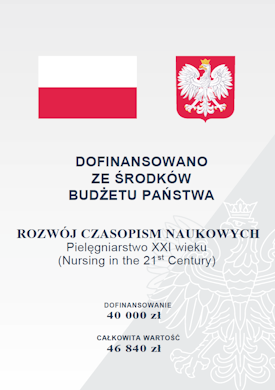Consumer attitude and health care delivery as perceived by patients and nurses
DOI:
https://doi.org/10.12923/pielxxiw-2025-0017Keywords:
patients, nurses, attitude, consumer, healthAbstract
CONSUMER ATTITUDE AND HEALTH CARE DELIVERY AS PERCEIVED BY PATIENTS AND NURSES
Aim. The study aimed to evaluate consumer attitudes towards healthcare services from the perspectives of both patients and nurses.
Material and methods. The study was conducted among 593 patients hospitalized at the Provincial Clinical Hospital No. 1 in Rzeszów and 300 nurses working in medical and surgical wards. The data were acquired from the Author’s Survey Questionnaire for Patients and Author’s Survey Questionnaire for Nurses.
Results. The level of acceptance for most of the statements was higher among patients (acceptance of hospital conditions – p =0.0000*, expectation of respect from the patient/nurse – p =0.0000*, receiving information about the illness – p =0.0000***, obtaining information about treatment methods – p =0.0000*, expectation of commitment from the patient/nurse – p =0.0000*, patients’ trust in nurses – p =0.0000*, the hospital meeting the expectations of the nurse/patient – p =0.0000*, lack of attachment to a specific hospital – p =0.0001*).
Conclusions. Patients seek the opinion of other people more often than nurses, and they expect nurses’ commitment and want to obtain information about their disease and treatment methods. On the other hand, nurses more often show the desire to be the best and exercise the right to submit complaints.
References
1. CBOS. Polacy o swoim zdrowiu oraz prozdrowotnych zachowaniach i aktywnościach. 2012. Accessed at: http://www.cbos.pl/SPISKOM.POL/2012/K_110_12.PDF (10.02.2020).
2. Lickiewicz J, Piątek J. Doświadczenie agresji w pracy pielęgniarskiej. Sztuka Leczenia. Zakład Psychologii Zdrowia Instytut Pielęgniarstwa i Położnictwa Wydział Nauk o Zdrowiu UJ CM, 2014; 3-4: 11-22. Accessed at: https://www.sztukaleczenia.pl/pub/2014/3-4/sztuka_leczenia_11-21.pdf (01.08.2024).
3. Bidaut-Russell M, Gabriel SE, Scott CG, et al. Determinanty satysfakcji pacjenta w przypadku przewlekłej choroby. Arthritis Rheum. 2002; 47:494-500. http://doi.org/10.1002/art.10667
4. Kautsch M. Czynniki warunkujące zachowania konsumenckie w ochronie zdrowia wybrane zagadnienia. Zeszyty Naukowe Uniwersytetu Szczecińskiego. 2010;16:242-243.
5. Szwamel K, Sochocka L. Opinia średniego personelu medycznego szpitalnego oddziału ratunkowego na temat agresywnych zachowań pacjentów. Piel. Zdr. Publ, 2014; 4(2): 149-154. Accessed at: https://dbc.wroc.pl/Content/30685/PDF/176.pdf (28.06.2024).
6. Szkup M, Rączka M, Schneider-Matyka D i wsp. Ocena ryzyka wystąpienia agresji wśród pacjentów zgłaszających się do placówek medycznych. Zdrowie Publiczne i Zarządzanie 2018, 16(2): 119-124. https://doi.org/10.4467/20842627OZ.18.014.9084
7. Tałaj A, Suchorzewska J. Postawy pielęgniarek i położnych wobec osób chorych i cierpiących w aspekcie obowiązujących norm prawnych i moralnych. Problemy Pielęgniarstwa. 2007; 15 (1): 32-38.
8. Dobska M, Dobski P. Zarządzanie jakością w podmiotach leczniczych. Warszawa: Wolters Kluwer Polska; 2012.
9. Nettleton S. The socjology of health and illness. Polity Press. Cambridge, 2001.
10. Freidson E. Zastosowanie teorii organizacji. Modele organizacji i usług w opiece zdrowotnej. Socjologia a zdrowie. [w]: Sokołowska M, Hołówko J, Ostrowska A, (red.). Warszawa: Wydawnictwo PWE; 1976.
11. Niewiadowicz-Czapska T. Agresja w pracy pielęgniarki: Magazyn pielęgniarki i położnej. 2010;3.
12. Ptaszek G, Stołecka B, Graf L, et al. Wypalenie zawodowe pielęgniarek. Pielęgniarstwo specjalistyczne. 2014; 1(4): 180-184.
13. Gallanger E. Ideologia konsumpcji a opieka zdrowotna. Socjologia a zdrowie.[w]: Sokołowska M, Hołówko J, Ostrowska A (red.). Warszawa; Wydawnictwo PWE; 1976.
14. Zúñiga F, Ausserhofer D, Hamers JP, et al. Are staffing, work environment, work stressors, and rationing of care related to care workers’ perception of quality of care? A cross-sectional study. J. Am. Med. Dir. Assoc. 2015; 16(10): 860-866. https://doi.org/10.1016/j.jamda.2015.04.012
15. Kim N, Jeong SY. Patient safety management activities of clinical nurse: A modified theory of planned behawior. Journal of Korean Academy of Nursing Administration. 2019; 25(5): 384-392. https://doi.org/10.11111/jkana.2019.25.5.384
16. Eren SS, Eren MS, Ayas N, et al. The eff ect of service orientation on financial performance: the mediating role of job satisfaction and customer satisfaction. Procedia - Social and Behavioral Sciences. 2013; 99(6): 66. https://doi.org/10.1016/j.sbspro.2013.10.537
17. Światowy G. Zachowania konsumentów. Warszawa: Wydawnictwo naukowe PWE; 2006, p. 98.
18. Henderson S. Power imbalance between nurses and patients: a potential inhibitor of partnership in care, Journal of Clinical Nursing. 2003; 12(4): 501-508. https://doi.org/10.1046/j.1365-2702.2003.00757.x
19. Dhaini SR, Simon M, Ausserhofer D, et al. Trends and variability of implicit rationing of care across time and shifts in an acute care hospital: a longitudinal study. J. Nurs. Manag. 2020; 28(8): 1861-1872. https://doi.org/10.1111/jonm.13035
Downloads
Published
Issue
Section
License
Copyright (c) 2025 Authors

This work is licensed under a Creative Commons Attribution 4.0 International License.




